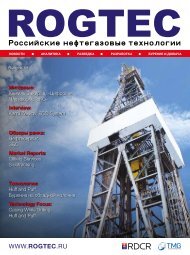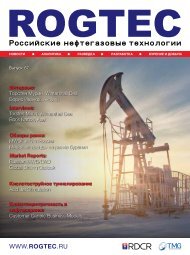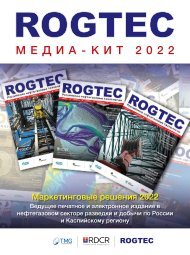ROGTEC Magazine Issue 55
ROGTEC, Russian Oil and Gas Technologies, Magazine is Russia’s leading upstream oil and gas publication. Produced with the aim of being the leading, independent, technology based journal for the Russian, Caspian, CIS and Eurasia regions. Covering from exploration through to drilling, completion and production technologies the ROGTEC publication works hand in hand with the regional Operators like Lukoil, Rosneft, Salym Petroleum Development, Gazprom, Gazprom Neft and many other. ROGTEC - The Engineers choice!
ROGTEC, Russian Oil and Gas Technologies, Magazine is Russia’s leading upstream oil and gas publication. Produced with the aim of being the leading, independent, technology based journal for the Russian, Caspian, CIS and Eurasia regions. Covering from exploration through to drilling, completion and production technologies the ROGTEC publication works hand in hand with the regional Operators like Lukoil, Rosneft, Salym Petroleum Development, Gazprom, Gazprom Neft and many other. ROGTEC - The Engineers choice!
Create successful ePaper yourself
Turn your PDF publications into a flip-book with our unique Google optimized e-Paper software.
RESERVOIR ESTIMATION<br />
полученная на керне, отобранном из скважины,<br />
пробуренной на безводном растворе (раствор<br />
на нефтяной основе). Все значения остаточной<br />
нефтенасыщенности по керну, которые были<br />
проигнорированы в предыдущих подсчетах запасов<br />
(более 40 % в интервале<br />
К, = 6.. .10 %, более 30 % при К = 10.. .12 %, более<br />
20 % при Кп = 12.. .20 %), относятся к определениям,<br />
в которые, наряду с остаточной нефтью, вошли<br />
жидкие битумы. В процессе экстракции образцов<br />
по стандартной методике в спирто-бензольной<br />
смеси пустотное пространство породы полностью<br />
очищается от остаточной нефти, а также от наиболее<br />
легких и подвижных фракций битума, не затрагивая<br />
твердые битумы, составляющие как бы часть скелета<br />
породы. Об этом же свидетельствуют и результаты<br />
специальных петрофизических исследований на<br />
небольших кусочках породы, образовавшихся при<br />
формировании образцов стандартных размеров<br />
(исследования выполнены в отделе пет-рофизики НПЦ<br />
«Тверьгеофизика»). Таким об-разом, предположения<br />
по параметрам Кно и Кво подтвердились, что<br />
позволило сформулировать алгоритм определения<br />
газонасыщенности и нефтенасыщенности в<br />
предельной зоне насыщения (см. рис. 5).<br />
Для большинства залежей ОНГКМ данные<br />
опробования свидетельствуют о широком диапазоне<br />
получения продукта (нефти и воды) в интервале,<br />
включающем ВНК. Данные испытания и опробования<br />
в этом интервале противоречивы и не позволяют<br />
однозначно определить уровень ВНК. Таким образом,<br />
не остается сомнений в необходимости учета в модели<br />
наличия переходной зоны в нефте-и водонасыщенных<br />
частях залежей, как это было сделано и для условий<br />
АГКМ на границе «газ-вода».<br />
В связи с отсутствием возможности построения<br />
модели переходной зоны по результатам<br />
интерпретации данных ГИС для ее оценки был<br />
использован подход, отраженный в методических<br />
рекомендациях В.И. Петерсилье [2] и адап-тированный<br />
к условиям ОНГКМ. Суть методики сводится к<br />
следующему. Прежде всего необходимо оценить<br />
уровень зеркала свободной воды (англ. free water<br />
level - FWL), ниже которого находится чистая вода.<br />
Оценка положения FWL была произведена по<br />
данным пластовых давлений в пределах нефтяной<br />
и водонасыщенной частей залежи и подтверждена<br />
статистическими данными о результатах испытаний, по<br />
которым еще оценивалась и высота переходной зоны.<br />
Оценка высоты переходной зоны подтверждалась<br />
результатами определения относительных<br />
фазовых проницаемостей, по которым были также<br />
получены зависимости для оценки остаточных<br />
nature of saturation and oil-gas saturation, to alternatively<br />
determine the latter, a method was developed based on<br />
the data of core analysis, well logging (induced gamma-ray<br />
logging) and the statistical evaluation of the results of tests,<br />
based on the petrophysical model, resulting from correlation<br />
of residual water saturation of non-extractable core<br />
(Kво) and effective porosity (Kp) (Fig.5). To determine oil<br />
saturation in the acrozone of the oil rim (КORF) interpolation<br />
was applied to correlation of residual water saturation<br />
and porosity, which was obtained on the samples of core,<br />
selected from the well drilled by the waterless method (oilbased<br />
mud). All the values of the residual oil saturation on<br />
the core, which had been ignored in the previous estimation<br />
of reserves (over 40% in the interval<br />
К, = 6.. .10 %, over 30% under K=10…12%, over 20%<br />
under Кп =12…20%), are related to determination, where<br />
liquid bitumens, alongside with oil, were entered. The rock<br />
porosity, in the process of sample extraction, carried out by<br />
standard method, gets completely clean of residual oil, as<br />
well as of the most light and fluent fractions of bitumen, not<br />
touching solid bitumen, forming kind of skeleton of the rock.<br />
This is also confirmed by the data of special petrophysical<br />
research, carried out on small bits of rock, formed during<br />
development of standard-size samples (research was<br />
carried out in the Petrophysics Department of the Scientific<br />
and Production Center “Tvergeofizika”).<br />
Therefore, assumptions on parameters КORF and<br />
КWL were confirmed, which enabled us to formulate<br />
the algorythm of determination of gas saturation and oil<br />
saturation in the ultimate saturation zone (see Fig.5).<br />
The exploratory well test data, for the most of deposits of<br />
the Orenburg oil-and-gas condensate field, give evidence<br />
of a broad range of ways of production (oil and water) in the<br />
interval, including OWC. The test and well test data, related<br />
to this interval are contradictory and do not make it possible<br />
to unambiguously determine the OWC level. Thus, the<br />
presence of transition zone in the oil and water-saturated<br />
parts of deposits should be taken into account in the<br />
model, just like it was done for the context of the Astrakhan<br />
gas condensate field at the «gas-water» interface.<br />
Due to the lack of possibility to build a model of the<br />
transition zone, to evaluate it, an approach was applied,<br />
based on the results of well logging data interpretation,<br />
which was reflected in the methodic recommendations,<br />
provided by V.I. Petersils [2] and adapted to conditions of<br />
the Orenburg oil-and-gas condensate field. The essence<br />
of the method can be defined as the following. First, it is<br />
necessary to evaluate the level of the free water level –<br />
(FWL ) under which water alone is located. The evaluation<br />
of the FWL position was performed based on the data of<br />
formation pressures within the oil- and water-saturated<br />
parts of the deposit, and was confirmed through statistical<br />
www.rogtecmagazine.com<br />
<strong>ROGTEC</strong><br />
37















